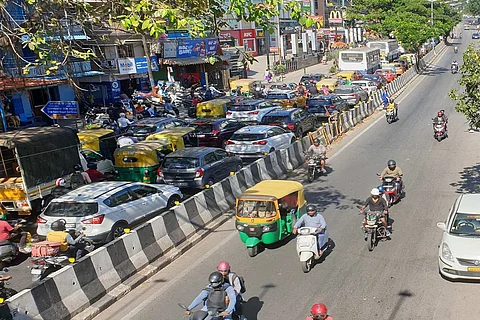

Breeze past the once hyper-congested, traffic-clogged Old Airport Road in Bengaluru. Banish all thoughts of tiring signal-waits. Don’t let those troublesome pedestrians slow you down. This was the grand promise of the signal-free corridor, billed as the ultimate congestion-killer. Today, those claims stand exposed, as a reality check raises several questions about such corridor projects. Linking Vellara Junction to Hope Farm Junction near Whitefield, the 17.5km corridor has been designed with three underpasses, one each at the Suranjandas Junction, Kundalahalli and Wind Tunnel Junction.
After much delay, the Kundalahalli project was opened in June 2022, and the Suranjandas Junction underpass in February this year. But there is no sign of work on the Wind Tunnel Junction underpass commencing any time soon. Land acquisition issues have forced the city corporation to put a temporary halt to the project. Result: Extreme congestion. Vehicles speeding past the Kundalahalli and Suranjandas Junctions queue up at the Wind Tunnel Junction, triggering cascading congestion on the approach roads.
Pedestrians are forced to take the skywalks that have sprung up at multiple locations across the corridor length. Senior citizens and the differently abled are told they could take the lift, but poor maintenance issues have shut down many such elevators at skywalks across the city. Inevitably, the physically weak are forced to jaywalk, coming into direct conflict with hi-speeding motorists.
This, mobility experts are convinced, is one of the fundamental flaws of what they call ‘quick-fix’ solutions to the congestion problem. “There is no denying the need for the city to be less congested, but the government believes the only way to do so is with haphazard band-aid solutions like signal-free traffic corridors, lane widening, and flyovers, which have repeatedly failed to work,” notes Nikita Luke, Senior Project Associate for Health and Road Safety at the World Resources Institute (WRI).
As tellingly illustrated by the failed flyovers, signal-free corridors too would only move traffic bottlenecks from point A to point B. Nikita points out, “This cycle will continue as vehicles speeding on these signal free corridors start backing up at the next junction. This is already happening and causing chaos, as we can see.”
For decades, flyovers have shown that they can only shift a problem. “It is amusing that the city administration has been making repeated attempts to decongest the city using the same erroneous theories for years now, in hope of a different outcome each time,” she says.
To bypass the clogged road, motorcyclists ride on the footpath and cycling path, jeopardising safety of pedestrians.
Beckoned by signal-free junctions, motorists move at very high speeds. Traffic calming measures, mandated by the Indian Road Congress (IRC) are bypassed. So is a concern for pedestrian and cyclist safety. Even without a corridor, walker safety has been severely compromised without proper pedestrian signals, midblock crossings and poorly laid footpaths.
Pedestrian deaths in 2022 rose alarmingly by 43% compared to 2021, as indicated by data sourced from the Bengaluru Traffic Police. Speeding by motorised vehicles led to 714 deaths. The arterial stretches on the city’s outskirts had a particularly high fatality rate, as they are signal-free enabling motorists to rev up their speeds.
Old Airport Road passes through the densely populated Murugeshpalya, Domalur, Marathahalli and other neighbourhoods with very high pedestrian movements. “It doesn't seem like the best idea to have a signal-free lane in such a densely pedestrianised location,” notes Nikita.
Wide-canopied trees lined the road’s stretches flanked by campuses of the Hindustan Aeronautics Limited (HAL). Consultants who first proposed the signal-free corridor in 2012 had declared that the project did not mandate road-widening and would thus not require any tree-felling.
In a decade, all that changed. Over a dozen 45-50 year-old heritage trees were axed to make way for underpasses designed to let motorists breeze through. Despite public protests, part of the green canopy that once cooled the Suranjandas Junction was sliced away.
Dozens of heritage trees older than 50 years were felled at the Suranjandas Junction to make way for a subway there as part of the Old Airport Road signal-free corridor.
Recalls Dattatreya Devare, a seasoned environmentalist and legal activist: “At the Suranjandas Junction, huge trees were cut without scientific proof that it is going to solve the congestion problem. At the Windtunnel Junction, trees were cut four to five years ago although no work has started even today. Now, eventually, when an underpass comes up there, just imagine the absolute chaos that will unfold at the Manipal Hospital crossing.”
The destruction of local ecology and congestion at corridor chokepoints are indicators of a flawed approach. Transportation engineering expert Dr Ashish Verma from the Indian Institute of Science (IISc) explains: “There is nothing like signal-free. Motorists can bypass a number of signals, but once the corridor ends, they will get stuck.”
Shaken by the tree-felling undertaken without a public consultation process or transparent communication, the public had protested to no avail.
Corridors create space, and by implication boosts vehicular speeds. “When they go faster on these signal-free corridors, the rate of flow, the throughput increases. But as soon as they get out of the corridor, the traffic gets clogged since at the exit, the rate of vehicular inflow is extremely fast. This creates severe choke points that take much longer time to relieve,” he points out.
Now comes the fundamental flaw. Signal-free corridors, like flyovers, are designed to reduce commute time. But, as Dr Verma says, motorists lose much of the time saved by the quick corridor commute by getting caught at the end choke points. “It is a similar story on the Bangalore-Mysore highway and the toll road to the Airport. People from the airport approach the Hebbal flyover junction at high speeds only to get stuck where the road ahead narrows down to two lanes.”